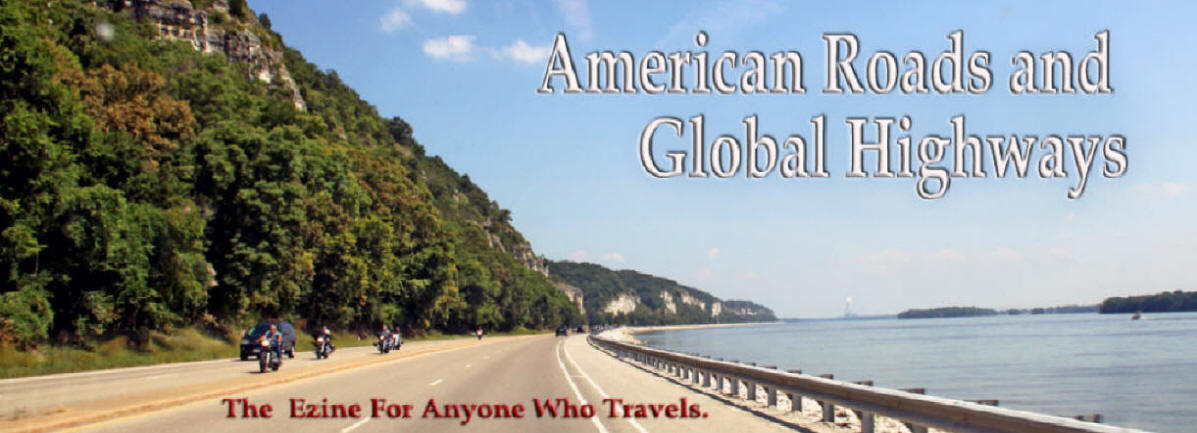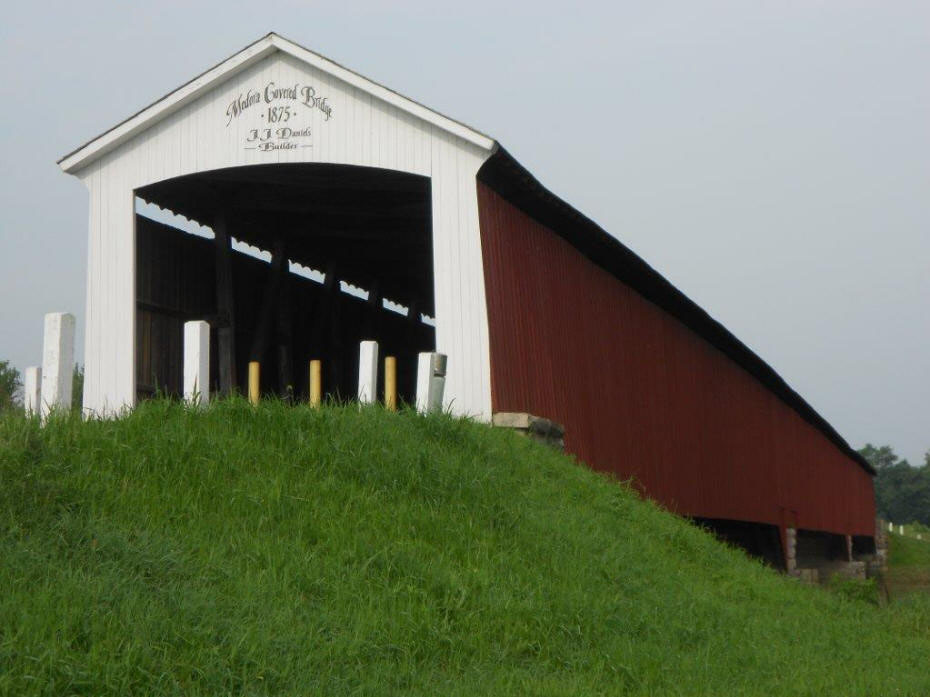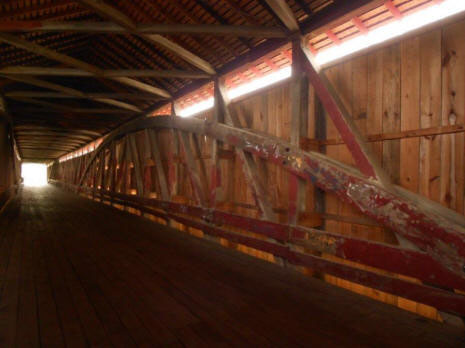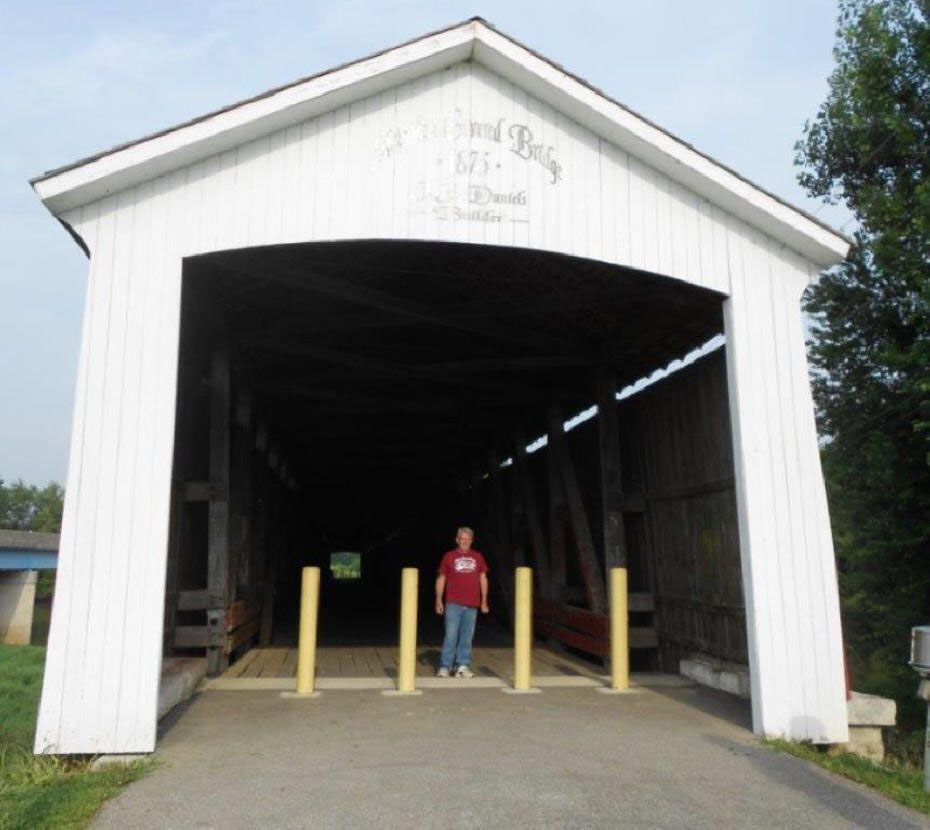
|
|
|
|
|

If you happen to be crossing Indiana on U.S. 50 or I-65, and would like an interesting side trip, America's longest historic covered bridge fits the spot. Built in 1875, at a cost of $18,142, it crosses the east fork of the White River about a mile east of Medora on Route 235. The bridge was used by U.S. 50 to cross the river from 1926 to 1950, when the U.S. highway was rerouted a few miles north. It was in use for regular traffic until 1973 when a modern bride was built along side of it. Since then it has been limited to foot traffic.
We're foresters and love to look at wood and wood engineering. What better place to do that than a covered wooden bridge? This one was built with oak and yellow poplar lumber, and is an arch bridge with three spans (the only covered bridge with three spans remaining in the state). It was built using Burr truss with king post construction methods. I know, what's that? Burr truss with king posts means it has wooden arches and the base of the bridge is supported by beams connected to the arch. It is a very intricate design and fascinating to view from inside the bridge. Lots of wood and lots of engineering. The center Burr arch on the south side shows the builders hand hewed the lumber used in each of the six sections of arches from a single tree over 40 inches in diameter. The 40 foot hand hewn upper chords, placed over both piers, (main horizontal beams on the bottom and top of the truss) even have expansion joints that allow for expansion and contraction due to weather. If you look close, the bottom chords bear the markings for placement on the structure. The piers and abutments have marking carved into them that are probably from the workers that quarried and built them.
Covered bridges are part of American history. The engineering necessary for them developed in the early nineteenth century. Their use was spurred by abundant timber and the need for improved travel and ways to get agricultural products to market. The bridges were covered for protection from the elements. If uncovered, the wood might deteriorate in a decade or so. The roof extended the life of the costly part of the bridge; the roof was cheap to replace relative to the rest of the bridge. It is believed that once there was a wooden railing down the middle of the bridge to separate traffic; as vehicles became wider the railing had to be removed. Most covered bridges have windows. Who doesn't want to look at the river as they cross? The Medora Covered Bridge has no windows and was referred to as "the dark bridge," especially as the middle it is notabaly dark due to its length. Is it the longest covered bridge? The longest covered bridge in the United States is the Smolen-Gulf Bridge in Ashtabula County, Ohio, at 612 feet. The Oho bridge was built in 2008, so is not historic. Notice the claim for being the longest refers to historic covered bridges. The Medora Covered Bridge has a clear span (abutment face to abutment face) of 431 feet. A second covered bridge in New England, the Cornish Windsor Covered Bridge over the Connecticut River between New Hampshire and Vermont, also claims the title, but its original trusses failed and had to be extended beyond the abutment faces for stability. The longer measure of that bridge is due to part of it being over land; its clear span is 422 feet. So the title can be argued, but the Medora Bridge is very, very long, no matter how you measure it.
In rural communities a covered bridge often was the only large covered space in the area, so it might be used for weddings, political rallies, or revival meetings. That tradition continues in Medora. Each August there is an annual catered dinner on the bridge, with entertainment. The bridge underwent major restoration in 2010 and it is currently in good repair. Besides its piers and abutments, the bridge has friends that support it. A group of volunteers formed a nonprofit group to raise funds and provide labor to see that the bridge and surrounding area are maintained. One of those friends, introducing himself as a "bridge troll" spent time with us showcasing the bridge's features and history. We were lucky enough to have the troll go to the trouble of coming from his task of policing the picnic area on the west side over to greet us on the east side. This was a weekday and we seemed to own the bridge. On a more crowded Saturday he might actually be on duty to welcome tourists. It is always a treat when someone with passion for an historic site explains its most interesting aspects.
Not all side trips need to major
stops. This one is only minutes off of U.S. 50 or I-65.
It's a wonderful stop; a perfect place to stretch your
feet, and there are even picnic tables. Maybe you'll
even get to meet the bridge troll. Authors: Thomas J. Straka is a forestry professor at Clemson University in South Carolina. His wife, Patricia, is a consulting forester. Both have a keen interest in history.
For Additional
Information Medora Covered Bridge Webpage http://www.medoracoveredbridge.com/index.htmll Indiana Landmarks https://www.indianalandmarks.org/2013/03/medora-covered-bridge Old U.S. Highway 50
http://www.scottseely.net/ScottSeely/The_Medora_Covered_Bridge.html Historical Marker https://www.hmdb.org/marker.asp?marker=74047
|
Connect with us on:
American Roads and | ||||||||||
|
Public Disclosure--
Please Read I recently learned of a FTC law requiring web sites to let their readers know if any of the stories are "sponsored" or compensated. American Roads and Global Highways' feature writers are professional travel writers. As such we are frequently invited on press trips, also called fam trips. Most of the articles here are results of these trips. On these trips most of our lodging, dining, admissions fees and often plane fare are covered by the city or firm hosting the trip. It is an opportunity to visit places we might not otherwise be able to visit and bring you a great story. However, no one tells us what to write about those places. All opinions are 100% those of the author of that feature column. |
|||||||||||
|
Privacy Policy/ Archives /
Contributors /
Subscribe to
American Roads Books by
Kathleen Walls /
Contact /
Sponsor or Advertise/ American Roads & Global Highways Home Page
|











